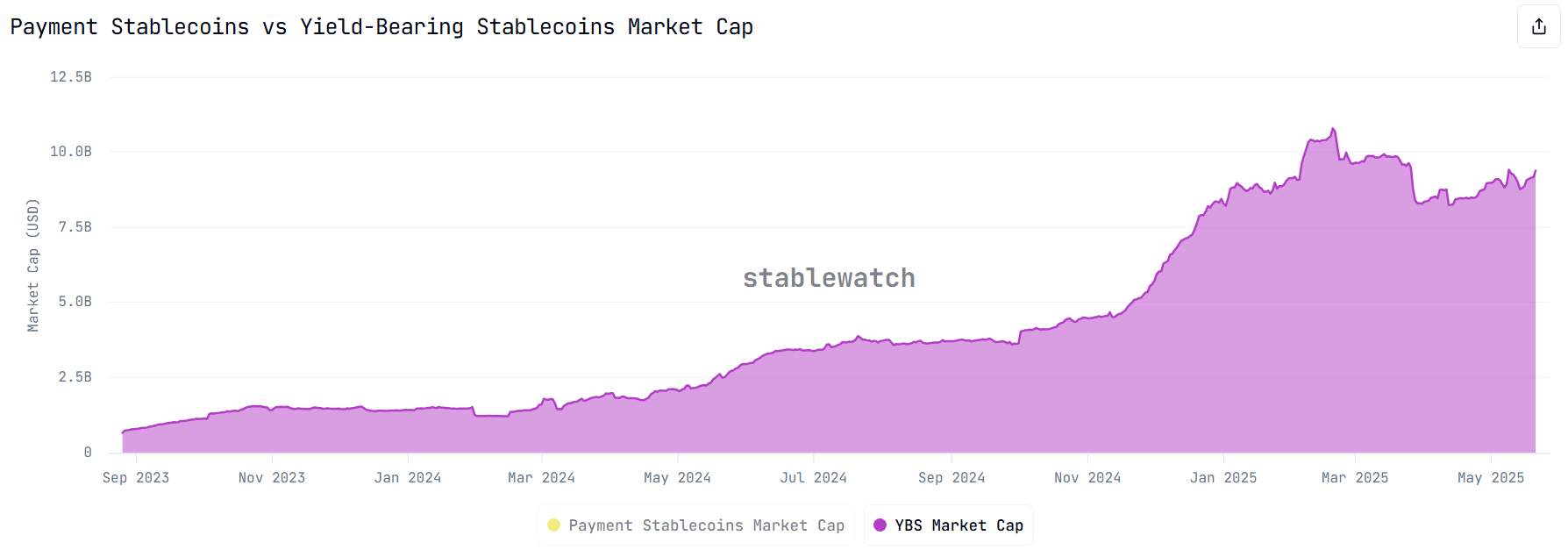| COINOTAG recommends • Exchange signup |
| 💹 Trade with pro tools |
| Fast execution, robust charts, clean risk controls. |
| 👉 Open account → |
| COINOTAG recommends • Exchange signup |
| 🚀 Smooth orders, clear control |
| Advanced order types and market depth in one view. |
| 👉 Create account → |
| COINOTAG recommends • Exchange signup |
| 📈 Clarity in volatile markets |
| Plan entries & exits, manage positions with discipline. |
| 👉 Sign up → |
| COINOTAG recommends • Exchange signup |
| ⚡ Speed, depth, reliability |
| Execute confidently when timing matters. |
| 👉 Open account → |
| COINOTAG recommends • Exchange signup |
| 🧭 A focused workflow for traders |
| Alerts, watchlists, and a repeatable process. |
| 👉 Get started → |
| COINOTAG recommends • Exchange signup |
| ✅ Data‑driven decisions |
| Focus on process—not noise. |
| 👉 Sign up → |
-
The yield-bearing stablecoin market has seen remarkable growth, reaching a total supply of $8.98 billion, a 13x increase since August 2023, with daily payouts averaging $1.5 million.
-
Both Ethena and Sky are leading the market, supported by over 1,900 yield pools across more than 100 blockchain networks, attracting significant investor interest.
-
Despite institutional interest, legal intricacies, particularly pertaining to MiCA and SEC regulations, present hurdles to widespread adoption.
This article delves into the burgeoning yield-bearing stablecoin market and the challenges posed by regulatory uncertainties, shedding light on its future potential.
Yield Stablecoin Market Cap Surpasses $10 Billion in 2025
Yield-bearing stablecoins distinguish themselves from traditional tokens by not only maintaining stability but also generating returns through various financial strategies like lending or staking. The sector has entered a transformative phase, drawing attention from both investors and regulators.
As presented by Stablewatch, the supply of yield-bearing stablecoins has surged from $666 million in August 2023 to a staggering $8.98 billion by May 2025. Notably, the market reached its peak at $10.8 billion in February 2025.
| COINOTAG recommends • Professional traders group |
| 💎 Join a professional trading community |
| Work with senior traders, research‑backed setups, and risk‑first frameworks. |
| 👉 Join the group → |
| COINOTAG recommends • Professional traders group |
| 📊 Transparent performance, real process |
| Spot strategies with documented months of triple‑digit runs during strong trends; futures plans use defined R:R and sizing. |
| 👉 Get access → |
| COINOTAG recommends • Professional traders group |
| 🧭 Research → Plan → Execute |
| Daily levels, watchlists, and post‑trade reviews to build consistency. |
| 👉 Join now → |
| COINOTAG recommends • Professional traders group |
| 🛡️ Risk comes first |
| Sizing methods, invalidation rules, and R‑multiples baked into every plan. |
| 👉 Start today → |
| COINOTAG recommends • Professional traders group |
| 🧠 Learn the “why” behind each trade |
| Live breakdowns, playbooks, and framework‑first education. |
| 👉 Join the group → |
| COINOTAG recommends • Professional traders group |
| 🚀 Insider • APEX • INNER CIRCLE |
| Choose the depth you need—tools, coaching, and member rooms. |
| 👉 Explore tiers → |

Yield-Bearing Stablecoin Market Cap. Source: Stablewatch
| COINOTAG recommends • Exchange signup |
| 📈 Clear interface, precise orders |
| Sharp entries & exits with actionable alerts. |
| 👉 Create free account → |
| COINOTAG recommends • Exchange signup |
| 🧠 Smarter tools. Better decisions. |
| Depth analytics and risk features in one view. |
| 👉 Sign up → |
| COINOTAG recommends • Exchange signup |
| 🎯 Take control of entries & exits |
| Set alerts, define stops, execute consistently. |
| 👉 Open account → |
| COINOTAG recommends • Exchange signup |
| 🛠️ From idea to execution |
| Turn setups into plans with practical order types. |
| 👉 Join now → |
| COINOTAG recommends • Exchange signup |
| 📋 Trade your plan |
| Watchlists and routing that support focus. |
| 👉 Get started → |
| COINOTAG recommends • Exchange signup |
| 📊 Precision without the noise |
| Data‑first workflows for active traders. |
| 👉 Sign up → |
The total yield payouts have accumulated to nearly $600 million, with an average daily payout of approximately $1.5 million. In this landscape, Ethena’s sUSDe and Sky’s sUSDS and sDAI lead the charge, comprising about 57% of the market with a combined valuation of $5.13 billion.
Further analyses from DeFiLlama reveal a robust ecosystem of over 1,900 yield pools distributed across 465 protocols and more than 100 blockchain platforms, enabling investors to engage and earn passive income effectively.
| COINOTAG recommends • Traders club |
| ⚡ Futures with discipline |
| Defined R:R, pre‑set invalidation, execution checklists. |
| 👉 Join the club → |
| COINOTAG recommends • Traders club |
| 🎯 Spot strategies that compound |
| Momentum & accumulation frameworks managed with clear risk. |
| 👉 Get access → |
| COINOTAG recommends • Traders club |
| 🏛️ APEX tier for serious traders |
| Deep dives, analyst Q&A, and accountability sprints. |
| 👉 Explore APEX → |
| COINOTAG recommends • Traders club |
| 📈 Real‑time market structure |
| Key levels, liquidity zones, and actionable context. |
| 👉 Join now → |
| COINOTAG recommends • Traders club |
| 🔔 Smart alerts, not noise |
| Context‑rich notifications tied to plans and risk—never hype. |
| 👉 Get access → |
| COINOTAG recommends • Traders club |
| 🤝 Peer review & coaching |
| Hands‑on feedback that sharpens execution and risk control. |
| 👉 Join the club → |
However, Jacek Czarnecki, co-founder of L2Beat, emphasizes that yield-bearing stablecoins still constitute a modest segment of the total stablecoin market, which currently exceeds $244 billion.
“Yield-first stablecoins are still just a small fraction (3.7%) of the general stablecoin market,” Czarnecki articulated, indicating a promising growth trajectory ahead as interest in these investment vehicles expands.
Challenges Facing the Yield Stablecoin Sector
Czarnecki also notes a significant challenge: the absence of a standardized definition for yield-bearing stablecoins. This ambiguity complicates the classification and evaluation of these financial assets.
To address this, he differentiates stablecoins into two categories: payment and yield. This simplification could pave the way for tailored legal frameworks that cater specifically to each type.
| COINOTAG recommends • Exchange signup |
| 📈 Clear control for futures |
| Sizing, stops, and scenario planning tools. |
| 👉 Open futures account → |
| COINOTAG recommends • Exchange signup |
| 🧩 Structure your futures trades |
| Define entries & exits with advanced orders. |
| 👉 Sign up → |
| COINOTAG recommends • Exchange signup |
| 🛡️ Control volatility |
| Automate alerts and manage positions with discipline. |
| 👉 Get started → |
| COINOTAG recommends • Exchange signup |
| ⚙️ Execution you can rely on |
| Fast routing and meaningful depth insights. |
| 👉 Create account → |
| COINOTAG recommends • Exchange signup |
| 📒 Plan. Execute. Review. |
| Frameworks for consistent decision‑making. |
| 👉 Join now → |
| COINOTAG recommends • Exchange signup |
| 🧩 Choose clarity over complexity |
| Actionable, pro‑grade tools—no fluff. |
| 👉 Open account → |
“Stablecoins are widely seen as crypto’s breakout use case. But to scale, we need a more user-centric framework. You shouldn’t buy coffee with your yield vault. Combining both types in one category (as many dashboards do) is like storing your paycheck in a hedge fund: technically possible, but it doesn’t make too much sense,” he explained.
Lawmakers are beginning to recognize this distinction, with the GENIUS Act in the U.S. indicating that stablecoins offering yields do not qualify as “payment stablecoins.”
| COINOTAG recommends • Members‑only research |
| 📌 Curated setups, clearly explained |
| Entry, invalidation, targets, and R:R defined before execution. |
| 👉 Get access → |
| COINOTAG recommends • Members‑only research |
| 🧠 Data‑led decision making |
| Technical + flow + context synthesized into actionable plans. |
| 👉 Join now → |
| COINOTAG recommends • Members‑only research |
| 🧱 Consistency over hype |
| Repeatable rules, realistic expectations, and a calmer mindset. |
| 👉 Get access → |
| COINOTAG recommends • Members‑only research |
| 🕒 Patience is an edge |
| Wait for confirmation and manage risk with checklists. |
| 👉 Join now → |
| COINOTAG recommends • Members‑only research |
| 💼 Professional mentorship |
| Guidance from seasoned traders and structured feedback loops. |
| 👉 Get access → |
| COINOTAG recommends • Members‑only research |
| 🧮 Track • Review • Improve |
| Documented PnL tracking and post‑mortems to accelerate learning. |
| 👉 Join now → |
This reclassification signifies that such assets may be deemed securities, placing them under the oversight of the U.S. Securities and Exchange Commission (SEC). Moreover, the European Union’s MiCA regulation prohibits interest payments on these stablecoins, further contributing to the regulatory complexities faced by this sector.
Yet, the increasing participation of established financial institutions in the stablecoin arena provides hope for a more flexible regulatory approach. For the market to achieve sustainable growth, projects must prioritize regulatory compliance, transparency, and comprehensive risk management strategies.
| COINOTAG recommends • Exchange signup |
| 🎯 Focus on process over noise |
| Plan trades, size positions, execute consistently. |
| 👉 Sign up → |
| COINOTAG recommends • Exchange signup |
| 🛠️ Simplify execution |
| Keep decisions clear with practical controls. |
| 👉 Get started → |
| COINOTAG recommends • Exchange signup |
| 📊 Make data your edge |
| Use depth and alerts to avoid guesswork. |
| 👉 Open account → |
| COINOTAG recommends • Exchange signup |
| 🧭 Be prepared, not reactive |
| Turn setups into rules before you trade. |
| 👉 Create account → |
| COINOTAG recommends • Exchange signup |
| ✍️ Plan first, then act |
| Entries, exits, and reviews that fit your routine. |
| 👉 Join now → |
| COINOTAG recommends • Exchange signup |
| 🧩 Consistency beats intensity |
| Small, repeatable steps win the long run. |
| 👉 Sign up → |
Conclusion
In summary, while the yield-bearing stablecoin market presents substantial growth potential, it also faces significant regulatory and operational challenges. As interest continues to rise among investors, addressing these hurdles will be crucial for facilitating broader adoption and ensuring the sector’s long-term viability. The ongoing dialogue between market participants and regulators will shape the future landscape of this promising segment within the cryptocurrency ecosystem.
| COINOTAG recommends • Members‑only research |
| 📌 Curated setups, clearly explained |
| Entry, invalidation, targets, and R:R defined before execution. |
| 👉 Get access → |
| COINOTAG recommends • Members‑only research |
| 🧠 Data‑led decision making |
| Technical + flow + context synthesized into actionable plans. |
| 👉 Join now → |
| COINOTAG recommends • Members‑only research |
| 🧱 Consistency over hype |
| Repeatable rules, realistic expectations, and a calmer mindset. |
| 👉 Get access → |
| COINOTAG recommends • Members‑only research |
| 🕒 Patience is an edge |
| Wait for confirmation and manage risk with checklists. |
| 👉 Join now → |
| COINOTAG recommends • Members‑only research |
| 💼 Professional mentorship |
| Guidance from seasoned traders and structured feedback loops. |
| 👉 Get access → |
| COINOTAG recommends • Members‑only research |
| 🧮 Track • Review • Improve |
| Documented PnL tracking and post‑mortems to accelerate learning. |
| 👉 Join now → |








